Trump’s Tariff Reversal: Impact on Crypto Markets and Global Trade Context
In a surprising development, U.S. President Donald Trump recently backtracked on his proposed 100% tariffs on Chinese goods, stating during a FOX Business interview that these tariffs will not endure. Just a week prior, he had announced the tariffs, which were intended as a strong measure in the ongoing trade war between the two nations. This shift in stance is particularly noteworthy amid the current volatility in the cryptocurrency market, where Bitcoin and other digital assets are experiencing a significant downturn, partly attributable to the heightened trade tensions.
Trump’s comments suggest a willingness to engage constructively with China, assuring that "they will be fine," indicating a potential easing of the friction that has characterized U.S.-China relations in recent months. Furthermore, he confirmed a meeting with Chinese President Xi Jinping is scheduled, underscoring his previously wavering interest in diplomatic engagement. This pivot raises questions about the sustainability of such tariffs, with Trump acknowledging that they aren’t a lasting solution. His emphasis on reaching a "fair deal" highlights a shift from aggressive posturing to a more negotiated approach.
The backdrop of these diplomatic shifts aligns with a dramatic crash in the cryptocurrency market. Bitcoin (BTC) reached an intraday low of $103,500, contributing to an alarming $19 billion loss across the crypto space within a single week. While Trump’s tariff announcements initially triggered fears and subsequent selling pressure in the market, his recent comments appeared to provide a temporary bounce, with Bitcoin moving back up to around $106,000. However, this volatility raises critical questions about the resilience of cryptocurrencies amid macroeconomic uncertainties.
Notably, the turbulence in the crypto market is fueled by more than just the potential for trade disputes. BTC is facing increased selling pressure from significant holders, including miners and market "whales." Reports indicate that over 51,000 BTC have been deposited into exchanges in recent days, projecting a bearish sentiment among large holders. This influx of Bitcoin onto exchanges may indicate a lack of confidence in the short-term price stability of the cryptocurrency, further compounding the market downturn.
Macro factors also play a crucial role in shaping the current climate of financial markets. Concerns about potential losses from bank loans linked to Western Alliance Bancorp and Zions Bancorporation are stirring apprehension among investors, leading to sell-offs in global bank stocks. As fears about the credit market’s stability grow, investors are increasingly seeking safe-haven assets such as U.S. Treasurys and gold, the latter of which is currently reaching new record highs. This flight to safety reflects broader anxieties regarding market stability amidst looming economic pressures.
Adding to the uncertainty, the prolonged U.S. government shutdown has injected further volatility into financial markets, as participants contemplate the implications of what could become the longest shutdown in history. The shutdown signifies not only a political impasse but also a broader economic concern that drives risk-averse strategies among investors. As Bitcoin falters, some traders are contemplating a possible dip below the psychological $100,000 barrier by year-end, with data suggesting a 72% likelihood of such an occurrence.
In conclusion, the interplay between trade negotiations, market sentiments, and broader economic factors is shaping a complex landscape for cryptocurrencies and other risk assets. Trump’s tariff reversal could signal a shift toward more diplomatic relations with China, but the immediate challenges posed by market volatility, large sell-offs, and macroeconomic fears complicate the outlook. Investors and market participants would do well to stay informed as these developments unfold, recognizing the critical connections between geopolitics, financial market dynamics, and the cryptocurrency landscape.


